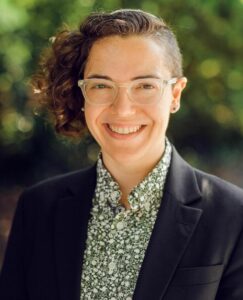By Rabbi Naomi Zaslow

Arriving just four days after Yom Kippur, Sukkot carries us from the headspace of Yom Kippur’s meditative contemplation into full joyful embodiment. Thematically, both Yom Kippur and Sukkot remind us that life and death are intertwined, and that life is fragile.
These two holidays are also linked by a shared theme of joy — the joy of a fresh start. The spiritual boost that we feel in our souls on Yom Kippur is then magnified by witnessing and giving thanks for our bounty on Sukkot.
Just as physically demanding as the rituals of Yom Kippur are, on Sukkot we swap out bodily affiliations — like abstaining from food, drink and intimacy — to embodied joy of God and community. We will eat and drink, or sleep in the sukkah, even as it wobbles and sways in the wind. We will allow ourselves to be held by the Divine. We will welcome in guests to share what we have, both from our actual families and community, and in the form of our spiritual ancestors, the sukkah guests of the ushpizin and ushpizot. The joy of Sukkot allows us to stretch what we physically have, to give more freely.
Since Yom Kippur and Sukkot follow each other in quick succession, with their shared focus on joy, what if we apply some of the spiritual practices of Yom Kippur to Sukkot? We have already done our best to apologize to others and to forgive others for our misses and mistakes of the past year. What if we use the time of Sukkot to let others know how they have brought us joy? What if we use this holiday of great simcha (joy) to share how those in our community have supported us, held us, made us laugh or believed in us? For much of our lives, we don’t actually know the positive impacts that we have on the individuals around us. We already prepared for Yom Kippur by stretching our capacity to ask for and extend forgiveness. Let’s use Sukkot to share with others how they have helped and changed us. What better way to celebrate the joyful living in Sukkot?
Think for a moment about this past year. Who supported you? Who touched your heart? Who taught you something new? Who made you laugh, who brought you joy? Let yourself turn these thoughts over, searching both for the constant sources of joy — and also the unexpected joyful moments in casual connections or difficult personalities. Next, the harder and more intimate task: extending the joy of Sukkot by expressing that gratitude. Reach out to the other person, and let them know how they brought you support or a smile. It can be through a text, a phone call or a coffee outing; over Chol HaMoed (the intermediate days of Sukkot) reach out in gratitude and share that moment of thanks.
Our tradition hints to joy and thanks on Sukkot being almost magical. The Chasidic Rebbe, the Sfat Emet, taught that the joy we experience on Sukkot is so potent, that this joy carries us through the rest of the year. He taught that Sukkot is like a vessel that gets filled with light and joy. Whatever joyous light is collected and stored in this time can be redistributed, spread out, across the year, tapped into when we (and others) need it most.
Outside of the mystical nature of his thought is a simple suggestion: The year has just started. Let us start it with joy. Let joy be the foundation of what is to come, the stage for this new year. May we be blessed to build our world up fully with Hakarat Hatov (gratitude) and joy, each of us bringing more thanks into this world.
Rabbi Naomi Zaslow was ordained at the Jewish Theological Seminary and serves as assistant rabbi at Beth El Congregation in Pikesville.





